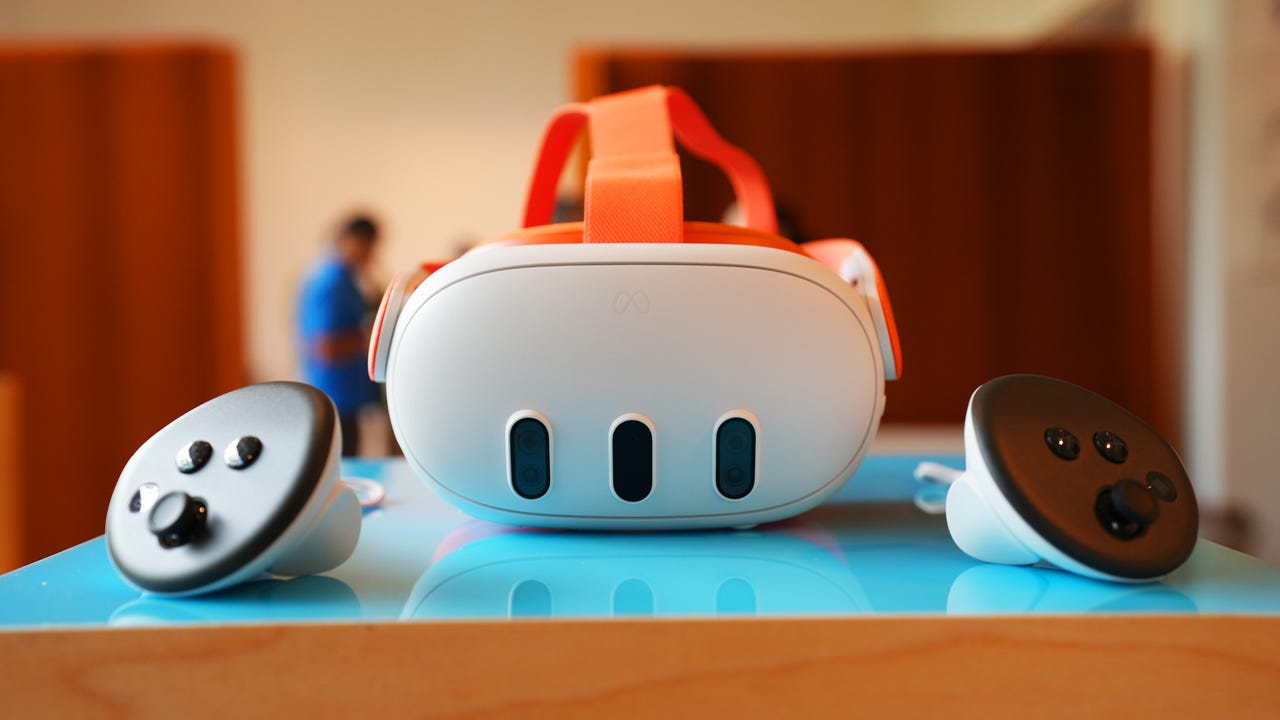
At the height of the pandemic, the then-named Oculus Quest 2 was the virtual reality (VR) headset that everyone was buying; leisure was limited to one’s living space, positioning the competitively priced headset as the definitive, most affordable gateway into virtual realities far, far away.
Also: This ultraportable VR headset gave me a taste of Vision Pro at a fraction of the cost
Three years later, after much of the VR buzz has been eclipsed by cutting-edge technologies such as generative AI, robotics, and even mixed reality (MR), Meta is releasing the highly anticipated successor to the Quest 2. The hope is to satisfy the enthusiasts who truly believe in a grand metaverse, while bringing fresh appeal to a market that, for the past year, has been carried solely by a $3,500 headset that hasn’t even been released yet.
Meta is pricing the Quest 3 with a starting rate of $499, $200 more than the previous Quest version initially sold for. So, what are you getting for the upcharge? Has Meta done enough to warrant your money and attention? Here’s my breakdown, after having spent an afternoon with the Quest 3 ahead of the Meta Connect event.
ZDNET RECOMMENDS
Meta Quest 3
The new VR headset features high-fidelity, full-color passthrough for an improved mixed reality experience and the latest Snapdragon XR2 Gen 2 chip.
View at Meta
To start, the most noticeable difference between the new and old Quest models is the design and form factor. That change was hinted at by Meta six months ago when the company straight up released the trailer for the Quest 3 a day before Apple unveiled the Vision Pro.
Also: These $400 XR glasses gave my MacBook a 120-inch screen to work with
The new headset is not only curvier and less bulky to wear, but it features an improved cushioning system that Meta tells me should help accommodate a wider range of users, including those with glasses. But even with the push-pull mechanism to expand the cushion, I struggled to fit my mid-sized frames within the headset, which I was able to do with the Quest 2.
Here’s a closer look at the new push-pull cushioning and orange colorway that Meta offers. June Wan/ZDNET
For users like me, it’s really a Hail Mary to set the prescription eyeglasses down and hope that the new range of interpupillary distances (IPD) is wide enough to suit my native vision. The alternative is to buy one of Meta’s VR prescription lenses, made in partnership with Zenni, for $50. I’ll be further testing the Quest 3 with those on to see just how effective they are for glasses-wearers.
Also: Watch out, Apple: Meta and LG are building a new Quest Pro headset
With the above image, you may have also caught a glance at the new pancake lens optical stack that Meta embedded. The hardware is similar to what was on the Quest Pro and significantly reduces glaring and other ghosting artifacts that typically weaken the immersive quality of VR experiences. The best part is that the pancake lens design allowed Meta to slim down the display side of the Quest 3 headset — 40% slimmer, to be exact — making it less front-heavy when worn.
Still, the company managed to up the display quality compared to the Quest 2 — remember, this thing costs $200 more — with dual 2064 x 2208 LCD panels that refresh up to 120Hz and 110 degrees horizontal and 96 degrees vertical field of view (FOV).
Just as important to highlight is the new camera array on the front of the Quest 3. There are now six sensors across the plastic grey cover, two of which are RGB cameras integral to the mixed-reality experiences that require more accurate color production and simultaneous localization and mapping (SLAM). Unlike the Quest 2, which depicted your surroundings in pixelated grayscale, passthrough on the Quest 3 feels much more photo-realistic.
That’s an invitation to use the headset for games and applications that blend digital overlays with your surroundings, as was highlighted when I demoed First Encounters and Ghostbusters – Rise of Ghost Lord. Before I even got into the gameplay, the Quest 3 leveraged its multiple sensors to map out my demo area, measuring the depth and distance of nearby furniture, objects, and walls.
Also: Meta has a secret VR headset that may have a key advantage over Apple’s Vision Pro
All of this guardian mapping was done hands-free; I didn’t have to draw the virtual safety zones with my controller as I used to do on the Quest 2, which was a burdenless experience that I didn’t know I needed.
The Meta Quest 3 is the first VR headset to feature Qualcomm’s newest Snapdragon XR2 Gen 2 platform, which boasts 2x faster graphics performance and improved load times. This was most noticeable when I hopped between several game titles during my hour of playtime. It certainly helps that the Quest 3 also gets a bump in RAM, from 6GB to 8GB. I’ll have to see how it all holds up with prolonged VR and MR usage. For now, I’m satisfied.
ZDNET’s buying advice (for now)
As mentioned before, Meta is selling the Quest 3 with a starting price of $499 for the 128GB model. That configuration should be good enough for dozens of VR games and app downloads, but if you need more, you’ll have to pay upwards of $699 for the 512GB variant. That’s right, Meta won’t be offering this year’s Quest at a 256GB tier, meaning you’ll have to settle with just enough storage or possibly too much.
Stay tuned to ZDNET for the full review of the Quest 3 headset, where I’ll be deep-diving into its performance, battery life, mixed reality applications, and more.
Featured reviews




















